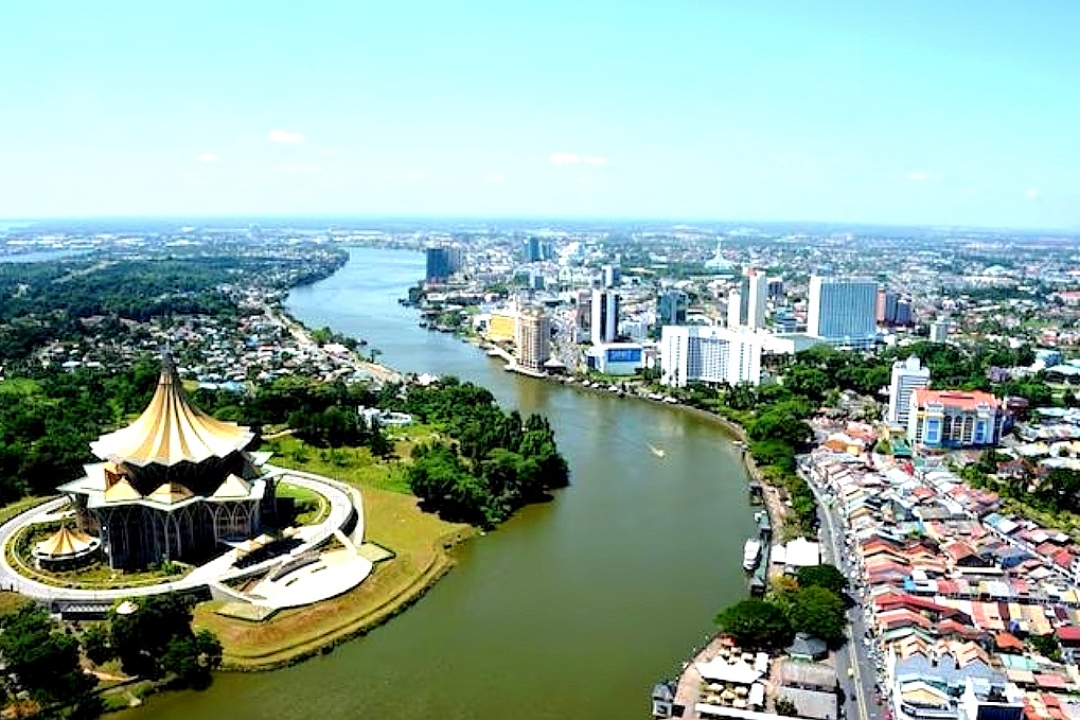
A file photo shows a drone’s eye view of Kuching Waterfront along Sarawak River.

I HAVE always been amazed, fascinated and surprised by the many similarities and differences between the two great cities located in Malaysian Borneo – they are models of what idyllic tropical paradises are like for those who reside in both these abodes of peace, as well as two of the most appealing destinations for tourists from around the globe.
Up to this very day, I still encounter on my travels to any peninsular town and also to the city state of Singapore the many taxi-drivers and casual acquaintances mistaking Sarawak for Sabah (somehow never the other way around), and also that they would refer to our beloved ‘midin’ fern as Sabah veggie!
I had first visited Kota Kinabalu (KK) in 1971 when I was 21 – at that time, Sabah was better developed and more progressive and was indeed more advanced than Sarawak in so many ways. The cost of living too was higher, by at least 25 per cent; one would very quickly find out that the food and drinks were a lot more expensive in KK.
Population-wise too, there were more people and there was a lot more economic activities and development there – even the nightlife appeared more exciting than in Kuching.
It had seemed to me that KK was enjoying the ‘winds of progress’ from the economic success and influence of Hong Kong (there were already direct flights even then), and there was the Filipino influence from the nearby Philippines, as well as that from the neighbouring Indonesian state of Kalimantan; indeed, its easternmost town of Tawau had Tarakan as a major border link.

Mabul Island, off the east coast of Sabah, is a diver’s paradise.
Sabah, in general, was more Cantonese/Hakka-speaking insofar as its major Chinese population was concerned, whereas Sarawak was more Hokkien, Teochew and Hakka, with Foochow in the central region. The timber boom of the late 1960s that had continued well into the 1990s had prospered Sabah greatly.
It had seemed to many that its political leaders were more flamboyant and ready and willing to wield their vast powers and influence, whereas in the then more ‘tame and stable’ politics of Sarawak, we were the quiet and more conservative brother. We would see change in the seats of political power at every state election, whereas in Sarawak besides the brief turmoil of the ‘Ming Court’ affair, we were stable and safe.
My earliest recollection of how different KK was to Kuching had occurred during our daily forays for food. At breakfast time, the majority of the coffee shops in KK had on offer very specialised choice of dishes, usually just one kind – if the shop had ‘ngiu chap’ (beef broth), it’s just that; or fish/seafood with noodles, it’s just that – and the list went on.
Most of the food was rather excellent, delicious in both quality and quantity, and prices seemed of no concern – oftentimes a bowl of seafood tomyam could cost almost double that of a Kuching bowl of noodle soup.
Due to KK’s proximity to the sea and their abundance of fresh and a wide variety of seafood, their quality has always been top-rate and their chefs’ cooking styles are very much different from that of Kuching’s.
In Kuching, you’d find instead of specialised kopitiams with one specialty dish on offer, there’d be a selection – usually within one coffee shop, there would be a minimum of two and a maximum of five or six stalls (nowadays, the trend after the early 2000s has been to build even bigger food courts with a dozen or more different stalls led by a drink supplier who is usually the shop owner/proprietor).
On offer, a visitor will find almost the same kind of breakfast/brunch food at every kopitiam – the essential ‘kolo mee’ (also serving choices of kuih tiaw, bihun and wanton); Kuching laksa, and either chicken rice, porridge, kuih chap, some Foochow specialty and/or nyonya kuih-kuih.
What also amazes many visitors from Peninsular Malaysia would be the presence of Malay halal stalls selling satay, mee Jawa, mee goreng, nasi lemak and other halal food.
Sometimes due to space constraints, the stall could even be located just next to a non-halal one selling non-halal food.
Another shocking experience for these visitors would be the sight of Muslim patrons happily seated together (if seating arrangements are so laid out) with others, enjoying drinks served from the same drink-maker at the back of the shop.
I’ve also seen Muslim customers happily enjoying laksa from a common stall (in fact, laksa itself is 100 per cent pork-free).
Probably the biggest differences in the foods available between KK and Kuching are in the availability of dim sums (a Cantonese word meaning ‘touch the heart’ – they are small portions of snacks) and the variety of bakut-teh (Hokkien word for ‘meat bone tea’ – pork ribs simmered in a broth of herbs and spices).
I was told that due to its Hong Kong and Kuala Lumpur (KL) influence (both places have big populations of Cantonese) dim sum is big in KK as breakfast and lunch fare, and there are many outlets offering some of the best dim sums you can find anywhere in this part of the world.
In Kuching, I can count on one hand the number of so-called dim sum places, of which my personal favourite has stopped serving since it lost its dim sum chef some months back.

A spread of delicious dim sums, Sabah-style, to be found in Kota Kinabalu.
A couple of others that remain are just so-so.
With bakut-teh, the variant on offer in KK is closer to that of the lighter and more pepper-ish Singapore Hokkien version, which I personally love. The ones on offer in Kuching is the heavier, darker and more herbal Klang and KL version. Not my cuppa tea!
So much for food!
I consider KK my second home having been in and out, and having worked sporadically there since the 1970s. I love it for its many differences from Kuching – its many attractions, beautiful places to go, different activities to do and over the years, I’ve met and made many good friends there. My wife’s family members have settled there since the 1970s and have called it home.
Where Kuching is quiet, serene, peaceful and somewhat on the sedate, mellow and rather unexciting side, especially in its nightlife, KK in my opinion tends to be more lively, somewhat chaotic, appears more edgy (and dangerous?) with its bright lights and a rip-roaring nightlife.
If Kuching could be likened to a middle-aged man in a steady civil-servant kind of way, KK for me is a single lady in her mid-40s leading a swinging lifestyle having the time of her life!
By day, Kuching would be a stroll in the Stutong Family Park, a visit to the Borneo Cultures Museum, shopping along archaic lanes downtown filled past antique shops and quaint old places, drinking Kopi-O and eating delightful dishes along Carpenter Street and Padungan, ending with a quiet night with friends at the Sarawak Club or at a friendly bistro like Junk or Zinc after dining at a restaurant like the Heritage or The Venue.
The free-spirited party-goer would frequent the new pubs and bars at Saradise and Galacity or elsewhere of a handful of upper-end bistros and night spots dotted around the city, probably ending the night with a simple supper at Lau-Ya Keng or the Open Air for late bites.
KK definitely has more to offer visitors – by day after a wide and varied choice of eateries of almost everything from great seafood dishes to delicious beef and other meats (and great Indian food too), one could plan to visit a nearby island for the day (boats are easy to find and trips are frequent), climb the splendid Mount Kinabalu or make a trip to Kundasang, or a road trip to Kuala Penyu or even to buy duty-free goods at Labuan (be prepared for a two-hour road trip and 1.5-hour ferry ride), or you can take the direct ferry from the city jetty.
You can also visit the local Filipino market, go see a mini-zoo or make a trip to any of the outlying small road-side towns (these too are plentiful in Kuching as well).

The small town of Siniawan near Kuching – a foodies’ paradise by weekend nights.
At night, KK takes on a life of its own – there’s the excitement of the KK Waterfront; we have this in Kuching, but there’s really no comparison as KK’s is vibrant, packed full of people of all races and walks of life.
It offers every variety by way of food and drinks, and if you’re more adventurous or have money to burn there’s the upper-end bistros and pubs lining the road leading into the city.
There’re nightclubs and places of entertainment too – just ask, and you can find virtually anything that your heart desires.
A really cosmopolitan city!
I’ve found that over the years and my long stretches of periods I’ve resided there, in general there’s a greater sense of adventure in KK, a much stronger purchasing power and I can say that a typical Sabahan tends to spend more and thus, enjoy a more lavish lifestyle compared to his Sarawakian counterpart in Kuching.
Kuching folks seem to be more reserved, very conservative and are unwilling to let their hair down – most tend to be more generous with themselves only when they are travelling outside their home base.
There is something that unites them – folks from Sabah and Sarawak all feel very strongly about their bond towards each other as ‘Malaysians from Borneo’, and do not take kindly to being either taken for granted or deemed ‘second-class citizens’ by Malaysians across the water.
They would stand as one to oppose any oversight, presumed slight or other derogatory treatment by anyone else.
They’re proud and outstanding citizens: the Malay, Chinese, Iban, Kadazan, Indian, Eurasian or any other race – and being regarded Malaysian of either Sabah or Sarawak origin.
Why that still needs reminding should no longer be the case!
